|
Link to: Overview
about a lot of articles leading to the mistakes of
present physics
And here is the first fact
To the model
errors of quantum mechanics,
To their correction,
By qualified engineer H.-J. Ackermann (chemistry)
Pseudonym: Arcus
Preface:
Let's say it clearly. What a state had the chemistry
in that time before Mendelejew found the periodic system
of the elements (PSE)?
Yes, it was alchemy, and it was a complete chaos of
crazy ideas what ever was possible using this kind of
art!
Precisely just this state today cosmology, cosmogony
and also particle physics are reflecting. We really live
in a "Pre-PSE-Time", projected at our
present time period - in the pre-world-formula-time.
What is missing else? You are missing that system! But
what predicted Einstein to be that system? He expected a
unified theory, so to speak a formula about the world
system. As long as this "PSE" of universe is
not given to the science, all the ideas will be swirled
mess filled of pure irrealism. And this although:
No single calculation and no single measurement of
the present sciences are wrong!
Only the models and their connection models are not
right. This is caused by the solution of my theory which
explains the particles in a completely different way
then it was done before. This means that the present interpretations
especially of the quantum mechanics and of the
relativity theory are wrong. The total system which
makes close the world at its inside is made from a
completely different view.
The first mistake made by Victor de Broglie
(1892-1987)
De Broglie predicted matter waves. They would be
formed by a particle wave. The mass of the
particle plays the primary role:
|
nh = m' v  w
= pw w
= pw w w
|
(1,1)
|
or nh = m' v Rw
h = h / 2
Rw = w
/ 2 w
/ 2
Planck's constant h extended with integer numbers n
is equal to the product of the relativistic mass
m' = mo / (1-v²/c²), of the velocity v and of the wave length
(1-v²/c²), of the velocity v and of the wave length w.
Relationship is completed by vacuum light velocity c. If
the magnitudes are shortened with 2 w.
Relationship is completed by vacuum light velocity c. If
the magnitudes are shortened with 2 radially then we get the wave amplitude Rw in
that product. The momentum of the wave quantum is pw.
radially then we get the wave amplitude Rw in
that product. The momentum of the wave quantum is pw.
Mathematics of this solution is correct. The
interpretation is wrong. Before 1924 de Broglie didn't
have enough information about the general relativity
theory, GRT, of Einstein (1879-1955) which was published
in 1915/16. Einstein predicted there would be
gravitation waves. They would arise with the movement of
masses. In his work he showed the parallel to
electromagnetic waves which are made by movement of
electric charges.
So called matter waves really are nothing else than
gravitomagnetic waves - gravitation waves.
Here the equations for comparison:
nh = m' v Rw
the gravitomagnetic momentum, the g.m. angular
momentum, the g.m. effect
|
n
|
(1,2)
|
the electromagnetic momentum, the e.m. angular
momentum, the e.m. effect.
Here the e.m. momentum is made of the
relativistically moved electric charge e', until now
only called as magnetic momentum   ´
= n ´
= n .
.
This analogy is extremely obvious. It means:
A rotating charge eo makes an electrically
caused magnetic field while its electric field is
rotating. In the meaning of me derived by GRT, a
rotating mass mo creates a gravitationally
caused magnetic field while the gravitational field is
rotating. We find here the start of the electromagnetic
wave and of the gravitomagnetic wave. Their wave
quanta are the photon and the fallon. Both are
extending over and along the stationary vacuum of
the universe.
Remark:
Present opinion is that the vacuum would be made
by compensations of Heisenberg's wave quanta. But
these are compensations of waves. The stationary
vacuum does not consist of wave quanta. It is made
by the two stable subparticles of the stable
elementary particles and of the two elementary
charges in complete rest. Along this stationary
vacuum body, Einstein conceived it with his solution
of the equalizing of gravitation and antigravitation
in 1917, and then he rejected it to be a
"stupid thing", all the types of wave
quanta are extending. The true stupidity of Einstein
was to reject this solution again. It was used by me
to create the background for the movement of the
exchange quanta.
Additionally, de Broglie didn't know the macroscopic
importance of the gravitomagnetic waves ("of his
matter waves"). A short time before scientists
noticed that also fullerons (carbon balls) have the
qualities of g.m. waves (of those "matter
waves"). This means that each angular momentum I of
an arbitrary mass m is forming the sum of all the
elementary angular momenta at the same event:
|
I = nh = m v r = (m1
+ m2 + ... mn) v r .
|
(1,3)
|
The compact mass body also can create a magnet field
like the compact charge of an arbitrarily large electric
current, but a gravitomagnetic field. That magnetic
field gravitationally caused is referred to the strength
of the attraction force of the electric charges and it
may not be underestimated if big masses are rotating.
Well, this is not meant that compact mass, made from one
complete cluster, would be rotating around its gravity
center but that many singularities of masses are
rotating on a ring. Therefore we expect the g.m. field
made by the differential rotation of masses.
Second mistake made by Werner Heisenberg (1901-1976)
and the following physics
Heisenberg established the mathematical relationship
which is called uncertainty relation since this time,
resulting explanation problems definitively:
The product of momentum change  p and of "position" change
p and of "position" change  X would be larger/equal to Planck's constant
X would be larger/equal to Planck's constant h/2.
How did Heisenberg think of the "position" X
of the particle? Aren't there measured the changes of
the wave amplitudes Rw, like above described, instead of the
particle position so that 2
Rw, like above described, instead of the
particle position so that 2 X =
X =  Rw:
Rw:
Therefore Heisenberg, followed by Max Born
(1882-1970), has made the amplitude Rw or X
equal to the position of the particle! Born told that
the amplitude square Rw² of the
"particle wave" would be a measurement for the
"position probability of the particles". This
would be made clear at the extended function to square:
How could Heisenberg and Born do this, and what
problems have they given to us?
At first the particle properties of electrons seemed
to be indicated at low intensity. At higher intensity
the same indications were noticed like they are
well-known of e.m. waves. Because of the indications of
the hits one thought these hits all have to be the hits
of the particles directly (dual-slit
experiment).
Nobody thought that a particle as such a thing cannot
be a hit itself directly.
To an interaction we have to add the momentum
exchange or the angular momentum exchange! If work is
made between quanta of two magnetic fields then there is
an interaction and also an area where the
momenta are reacting with the other momenta.
How did one think the mistake particles themselves
would be indicated? At lower intensity, indications seem
to reflect the particles themselves. But this assumption
is also wrong. What does my theory tell us?
Stable particles like protons, electrons and definite
neutrinos, have a rest mass or a rest energy after the
equation E = mo·c². Because the energy E
can be also calculated with Planck's condition E = h·f
into a frequency f, each stable particle should make a
constant intrinsic oscillation of its space in rest. The
result means a spherical wave which is falling back next
to zero from the high point of its elongation - the
amplitude Ro. It looks like a pulsating
heart.
Elongation in an arbitrary cosm
(illustration 8.1;2 of my theory)

This oscillation is given by Schwarzschild's solution
of GRT. That solution I have solved deeper. A term was
resulting which gave the harmonic oscillation of stable
cosms. Here one can find the agreement between my
oscillator-solution (Arcus, 1986) and of Planck's
theory. Each cosm is an oscillator. It represents the
program of each life. At the same time it makes a
hierarchy of cosms up to the oscillating universe. Under
these circumstances waves cannot really be seen as
particles or signed as such things! On the one hand
there are
- particles and their primary momentum exchange of
their oscillation functions; on the other hand there
are
- the moved particles and the secondary momentum
exchange of their wave functions.
Primary wave quanta represent the same picture of
oscillation into all directions. Therefore they are felt
as monopolar states (see illustration above: pulsations
of a sphere are spatially equal).
Because of the oscillations of the spheres of
particles it is possible to compensate particles with
antiparticles in their contrary vibration. While a
proton is expanding an antiproton should be contracting.
The stationary vacuum remains. If a real particle is
oscillating then it transmits the own picture of its
movement over the primary particles and antiparticles
making vacuum. Practically all over the space primary
wave quanta are running from particle to particle
and vacuum quantum to vacuum quantum (short distance
effect). This kind of wave quanta is not identical with
the well-known secondary quanta of waves. Primary quanta
transmit the effects of gravitation mo and
antigravitation mo as primary
fallons and the effects of the electric charges +eo
and their anticharges -eo as primary
photons. Their frequencies correspond to the resting
frequencies of the particles themselves in relative
rest.
Here an active exchange of primary effects is
running into all directions. Einstein set a limit to
this event: if there will be enough mass, but also
enough momentum mass of secondary wave quanta, then the
coordinate system will be curved up to the end. The GRT
is not in contradiction to my opinion of the quanta and
their interactions. The reason is that the exchange
forces are forcing every body into curved orbits. If
there are centers of force at all so all the orbits lay
curved above them. Therefore it is wrong to describe
Einstein's GRT alone to be a geometric theory of
gravitation. Consequently, it is wrong to mark the GRT
as pure space-curvature theory. It is also wrong to
assert that GRT would negate the exchange force of
gravitation. Till now, nobody still had solved the GRT
completely so that its oscillator solution would have
been recognizable, before me.
Quantum mechanics was made by wrong interpretations.
Heisenberg saw the momentum exchange as an exchange of
"virtual particles". The next wrong conclusion
was to see the vacuum being a space of "virtual
particles". But the stationary vacuum exists
primary. Inside of it elementary angular momenta of real
particles are wandering to and from each other.
Therefore there is no vacuum of "virtual
particles" which would only live shortly and then
die again after the uncertainty relation of Heisenberg.
This complete interpretation made for model is wrong.
But independent on this there is a stationary vacuum of
primary particles.
As soon as a particle doesn't rest referred to its
partner then the relative velocity v appears. It leads
to the phenomena of secondary wave quanta after de
Broglie and after the electrodynamics. This way
secondary photons and secondary fallons will be formed.
They play an important role at higher velocities. Their
indication have confused Heisenberg, Born and present
physics. They thought that there would have been proved
the immediate proximity of the particles. But there the
interactions of quanta were indicated, so the secondary
angular momenta of the moving particles. The particles
themselves never have changed their direction! Particles
never have wave properties or qualities. But they are
receiver or transmitter of primary wave quanta because
they are oscillators themselves. In relative movement
particles become causes of a second type of wave quanta,
of secondary wave quanta which are reflected by
their bipolar magnetic fields.
Really the particle was not indicated as such a one
because its primary wave quanta express only the
properties of rest mass and of rest charge. But the
momentum of movement of that particle was indicated.
Just like this the position of the particle was not
indicated but the wave amplitude Rw of the
particle which was in movement.
In the end everything is expressed by uncertainty
relation, the primary wave quanta and the secondary wave
quanta, but in a completely new interpretation.
Rotation of a current of masses or
charges and their elongation (illustration 8.1;1 of the
theory)

Here the field changes its polarizing or its field
strength swells with small movements.
Remark:
The normal electrically caused magnetic field, which
propagation is a change of the transversal wave, really
is the result of the twist of the primary field. That
primary field consists of a spherical longitudinal wave
- of a spherical Tesla wave. This way I think, that
every transversal wave at each dipole antenna must have
a change of its primary longitudinal wave by which the
secondary longitudinal wave comes from. Both wave types
are coupled then.
The cohesion between momentum and wave amplitude
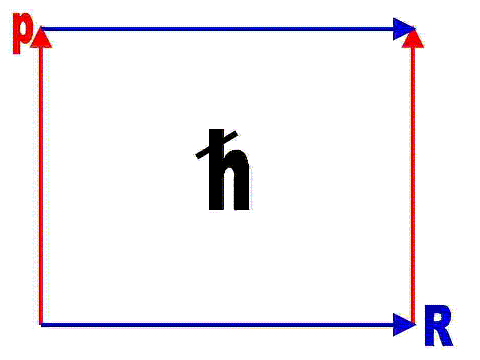
Here the amplitude R can be
substituted for the primary amplitude Ro of
cosm and for the secondary amplitude Rw of
wave quantum. The momentum stands firstly for the
momentum of the cosm po = mo·c
for R = Ro and secondly for the momentum of
the wave quantum (of the magnetic field) pw =
mw·c = m'·v for R = Rw, where mw
is the momentum mass and also for the non-indicated wave
quantum momentum pB = mB·v with R
= rrot.
The area h is
always constant. It only can be extended by
integer numbers of itself! You can see now why: This
area cannot be divided or enlarged. It is a unique
and fundamental magnitude given by God! But where
does ½ h of Fermions come from?
This is a secondary effect caused by rotations of
charges inside of the particle on half the amplitude
while its oscillation with an integer h.
It means: the area  of
an electromagnetically fundamental constant of
an electromagnetically fundamental constant  h.
For primary oscillations and secondary waves the same
law is valid. But the things are not the same!
The relationship which is shown above doesn't
construct any contradiction between particles and waves.
Heisenberg thought there would be a contradiction and
tried to overcome it with his variant of interpretation.
Our interpretation shows the unity of wave functions and
oscillation functions better. Additionally we see the
angular momentum as the determining element of
oscillating matter. The same relation is valid for the
so-called uncertainty of energy and time. Primarily this
is the oscillation energy of oscillators, secondarily it
is the wave energy of wave quanta. The time isn't a
general time, but the period time of oscillators (I
called it oscillation time) or the period time of wave
quanta. The area h represents a thing like a constant
programming of matter. If it would not exist then the
matter would be completely free, and it could decay
absolutely accidentally. Additionally in connection with
the world formulae this solution proves that the matter
including particles and energy represents a programmed
system.
If the given context is not enough to explain why X
equal to Rw isn't the position of the
particle, I give the following explanations.
Heisenberg wasn't master of the special relativity
theory, SRT, at his time. Otherwise he had exactly
separated the observer relations. This mistake couldn't
be corrected by consideration of terms of SRT in quantum
mechanics afterwards, only used for indications. There
the resting observer is at the place of the indicator
and at the place of the totally braked particle and its
wave quanta. The mass is relativistically stopped seen
as m'. Then the momentum pw also became
relativistic. The more the mass m' increases with
increasing velocity v the smaller is the amplitude Rw.
My solution clearly explains the cohesion to the SRT.
It is told the mass will be increase relativistically
along increasing velocity. To which observer is this
reflection valid? At the impact the indicating observer
notices a relativistically increased mass m'. Now the
cause of it is the same as it appears at secondary wave
quantum exchange: the frequency of primary exchange
waves is shifted to the blue. Because after my theory
the resting gravitational particle has a definite
frequency f which practically reflects the rest mass mo
of the particle, the frequency f ' is shifted to the
blue over the exchange momenta and then it represents
the bigger mass m'. But the relationship behind the
escaping mass was not explained by generally formulated
SRT of Einstein. There the frequency is shifted to the
red. The moving mass mB will be lighter with
SRT position:
|
mB = mo · (1-v²/c²)
. (1-v²/c²)
.
|
(2,1)
|
If now the moving mass mB isn't indicated,
but it is rotating on its orbit radius rrot
then it doesn't reflect the equation (1,1) but the
following:
With increasing relativistic velocity
the mass mo is decreasing down to mB
while the rotation radius rrot may be
arbitrary.
The particle is there where its rotation radius is!
But the particle is not there where its secondary wave
quanta are landing at indication:
|
nh = m' v Rw = mo
v Rw /  (1-v²/c²) (1-v²/c²)
|
(2,3)
|
|
nh = mB v rrot
= mo v rrot · (1-v²/c²)
. (1-v²/c²)
.
|
(2,4)
|
It is expressed in differences of uncertainty
relation:
Consequently, we cannot speak of the equality of the
positions of the electrons rrot and their
wave amplitudes Rw. This will be clearly seen
with both following illustrations. The first
illustration from my theory marks the relativistic mass
m' with mA. We see the cohesion between the
moving rest mass mB and the momentum mass mw.
Both masses don't lay in the same point. Therefore there
is no "position location" of particle. And, an
elementary particle cannot be the same as its wave!
The indicated momentum p of a wave quantum which
just had an interaction is p = m' v = pw =
mw c. This relativistic retardation
momentum is not equal to the wave momentum pB =
mB v while the unchanged and
non-indicated movement of the particle causing its
own wave quantum!
The second part of the uncertainty relation is
referred to time and energy:
One thought that an interaction would exist during a
time uncertainty and after this it would disappear
again. This interpretation led to the mistake. Really it
has to be explained like following:
A real particle is oscillating spatially. It gets
bigger up to its amplitude R(X) in the time tx.
During this process its energy Ew
corresponds to the oscillation energy which one can
calculate into its oscillation mass m called rest
mass of that particle. Then the particle radius
decreases on a minimum again. For a short time the
particle doesn't exist any more. Then it will be
reborn. A pulsation like a heart!
This event is not equal to vacuum. It describes the
behavior of real particles! Exactly for them is valid:
|
h = E · to
= Ro · po .
|
(2,8)
|
Relativistic masses referred to vacuum (illustration
8.2.5;1 of my theory)
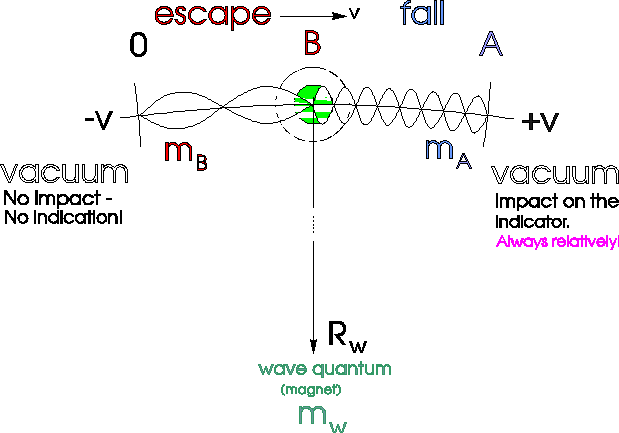
|
a) particle
|
b) particle orbit
|
|
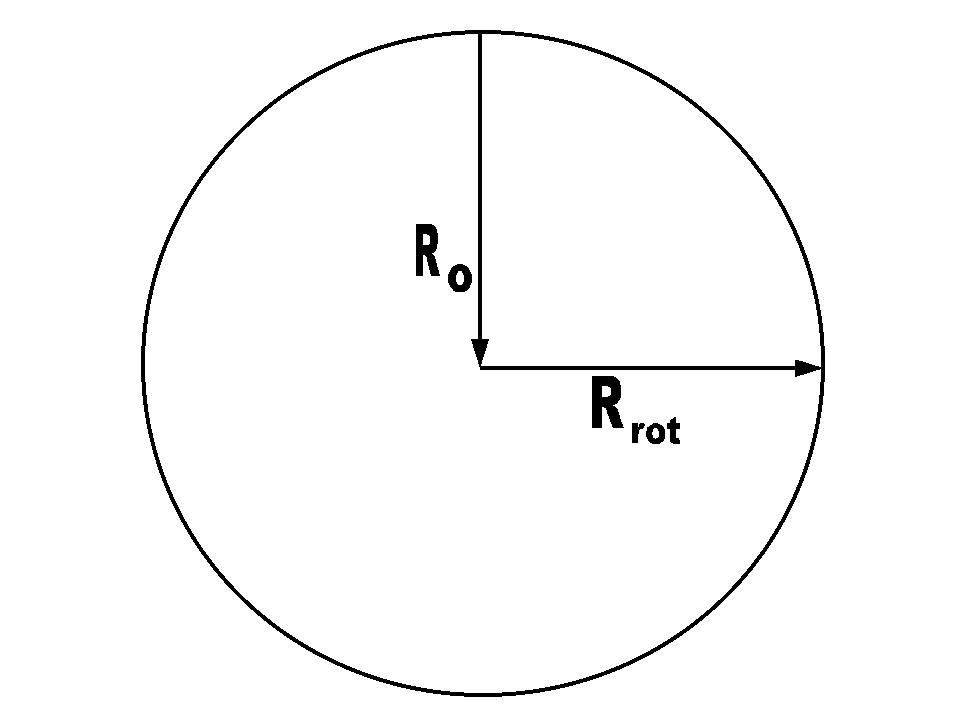
|
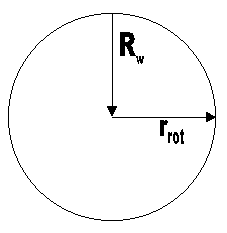
|
Have attention, please:
The particle as such a one does not contact the
indicator directly by interaction! The center of a
secondary wave amplitude has its interaction with the
indicator! That's the central dot of the orbit (always
curved) if the rotation radius is next to the wave
amplitude at small velocities. But there are all the
virtual central dots of all the wave amplitudes of the
main quanta and their sub-quanta! These interaction
indications have to be seen all around the particle
coming from it and going out into the space.
We observe an electrical
circuit in the shape of a single track conductor with
the rotation radius rrot. The electrons are
rotating there where the vector of that rotation radius
rrot shows from the center (the middle dot)
to the rotating electron. It draws the circular
movement. But where ist the amplitude Rw
which is caused by the rotating electron? If you
orientate a magnet to the electrical circuit, so it does
not be attracted to the electrons on their orbit but
into the center of the electrical circuit. There the
vector of the wave amplitude Rw shows to!
Consequently, both vectors of rrot and Rw
are contrary to each other as already proved above
relativistically! There is no equalitiy of the amplitude
Rw and the places at rrot of the
particles, in such a way no equality of wave and
elementary corpuscle, too! The theory of the
corpuscle-wave-dualism is an error!
The resting particle mass is indicated by its
interaction center in Ro as gravitation.
Above the apparent point-like being of the particle
doesn't lay the "vacuum polarizing" of quantum
mechanics but there are the innumerable subparticles
balanced charged up to the upper subparticles. The upper
subparticles are rotating on their radii Rrot.
So the quantum theory has measured a cloud of
electrically positive and negative poles above the
electron-"point" those space has an extension
of about 10-13 m. But this is not the true
vacuum polarizing! Here is an interpretation mistake of
quantum mechanics again. This space above the point-like
particle is filled with the subparticles of electrons,
with the subordinated particles which come from the
electron's protocosms. Protocosms are unstable particles
which are emitting radiation and stable particles in the
end at their decay. All these things remain locked under
the horizon of the electron of 3.9·10-13 m
calculated after my theory.
This means: physics has already recognized the
structures of some particles without knowing this,
because de Broglie and Heisenberg have led the following
generation into the lunatic.
But there were more mistakes. Quarks are only
interaction photons and fallons, which give an
information about a type of subparticles. But they don't
give information about the number of all the
subparticles inside of the definite particle! It's just
like this with Z- and W-bosons.
The true and real vacuum polarizing is
insignificantly extended in the space that its
measurement is relatively hard. At least the vacuum of
masses and charges is partially separated. It forms the
stationary field of gravitation and the electric field.
As soon as the masses and the charges will be moved the
given field will be twisted. It will be converted to a
rotation field which one calls magnetic field. Now there
are two types of it - the g.m. and the e.m. field.
When a front of magnetic field quanta with their
angular momenta comes to one single and relatively
resting magnetic field, they are interacting with the
single field over a complete area, because the resting
field can be extended from minus to plus infinite state,
cf. illustration 2.22,1 of my theory:
Explanation of German concepts here above: Kern =
core or nucleus, Hülle = shell
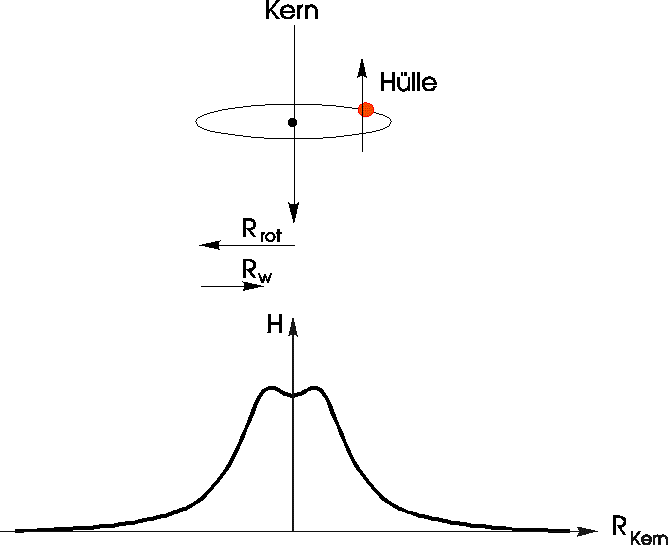
That magnetic field non-relativistically has its
largest interaction force H in the distance of zero from
the core or the nucleus. The more relativistic a
particle is rotating the more two peaks are shown
besides the peak point of the curve. While rotation of
electrons these distances are very small. Therefore the
model of electron shell by Erwin Schrödinger
(1887-1961) is mistaken. Following Heisenberg's ideas he
put the central interaction to the outside onto the
electron orbit in his opinion model explaining the right
mathematical solutions. So the reality was mirrored.
This cannot remain so although the calculations cause on
the wave function. In principle it calculated the right
wave amplitudes but no rotation radii. My theory shows
it simply: the electrons couple over the elementary
magnetic fields of their orbits making chemical
compounds. The orbits of electrons exist objectively in
reality without that they would be measurable.
Interactions of orbit magnets of electrons are
distributing themselves over a theoretically infinitely
large space - over an orbital of interactions.
Relatively reversed the event is working if a single
magnet field quantum collides with a multiple number of
momenta on an indicator. That indicator includes a
multitude of interaction fields of the particles there
which are standing in relationship to the hitting
angular momentum. The resulting effect is relatively the
same as the above called process. Just this drawing
nobody has really understood.
Interactions between two electrons, abstracted of
their orbit, are determined by their charges, their
masses (both are oscillation functions of both primary
fields of the world) and by their e.m. momentum and
their g.m. momentum. Such interactions are running when
an electron pair has got a orbit.
2. Refutation of the present interpretation of the
quantum mechanics
2.1. The meaning of Planck's constant
Planck's constant h is an effect, an action or just
the elementary effect quantum. Effects are working with
each other. This process is called interaction.
Let us look at the meaning of the equations.
At first the equation (1) can be understood as if the
wave length w
would be a perimeter u of a
circle which is made of the amplitude being a radius
Rw: w
would be a perimeter u of a
circle which is made of the amplitude being a radius
Rw:
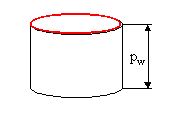  w
= 2 w
= 2 Rw
= u . Rw
= u .
Then the momentum pw could be understood
as height of a cylinder mantle. That cylinder mantle
itself would be the symbol for one interaction h at all
multiplied with the level n. In its area there is the
probability of the interaction. But we don't find there
any position probability of some particle. Such an
interpretation of positions was given by Max Born
although it is invisible from mathematics. The
interaction had to be the same as the particle. There
where a particle position would be its interaction had
also to be located. Then Born would be right. But is
this correct?
We square the equation (1) and get the following
term:
n² 4 ²
² h²= pw² 4p
²Rw²
Then we divide it by 2 and find the following equation:
and find the following equation:
n² 2
h² = pw² 2 Rw² = pw² Aw.
Rw² = pw² Aw.
There we get the circle area Aw made of
its amplitude and the height of the cylinder made of the
momentum square pw². Now this product
represents the volume of that cylinder. Inside of it the
square interaction is localized. Just in this function
we do not find any direct note of that particle. Instead
of this we only find the interaction with Planck's
quantum.
The more n we set in (up to infinity) the better we
see that the interactions are made in a successively
extended area of the mantle or of the volume of the
cylinder.
2.2. Which effect has the stable particle itself?
I understand the effect of a particle like the
electron to be a locked or closed oscillation of its
space during its time referred to one single
Planck-quantum h:
|
h = mo c  o
= po o
= po  o o
|
(5)
|
h = mo c Ro
= po Ro .
|
(6)
|
Then that quantum h reflects the resting mass mo
of that particle. The oscillation length  o
represents the perimeter uo of the falling
and elongating spherical space. That elongation amounts
Ro. The oscillation itself radiates the rest
momentum po of the primary exchange wave into
all directions. This momentum practically represents the
signal for the dimension of rest mass mo
which is transferred to the other resting masses. The
momentum exchange leads to the effect of rest mass
attraction, to the gravitation force in the end. In this
respect the quantum h is here the interaction of
gravitation. o
represents the perimeter uo of the falling
and elongating spherical space. That elongation amounts
Ro. The oscillation itself radiates the rest
momentum po of the primary exchange wave into
all directions. This momentum practically represents the
signal for the dimension of rest mass mo
which is transferred to the other resting masses. The
momentum exchange leads to the effect of rest mass
attraction, to the gravitation force in the end. In this
respect the quantum h is here the interaction of
gravitation.
The hit of a particle which is moving with the
velocity v and the mass mo therefore cannot
be the mass effect itself. The
mass effect has already been used! It is
switched by the exchange of primary rest momenta. Then
the oscillation velocity c of elongation Ro
is valid. But if a particle is moved with the velocity v
then it cannot be valid the velocity c. Consequently at
indication of particle-caused waves we never observe the
direct interaction of the particles. We never indicate
their locations or positions. Instead of the particle
positions we notice the interactions of the wave quanta
made by particle velocity of v. These effects do not lay
a priori at the inside of the particles but each on the
wave amplitude Rw. A particle never is
indicated itself but always its wave is indicated with
its relative velocity v referred to light velocity c!
This way the wave energy Ew which is able
to be indicated distinguishes of the (gravitational)
rest energy Eo:
|
Ew = m' v c = pw c = mw
c²
|
mw = m' v/c
|
(7)
|
|
Eo = mo c² .
|
(8)
|
There the momentum mass mw of the wave can
be found which reflects the really indicated effect h of
an arbitrary wave.
2.3. Corrected statement after Max Born
The statement of Born had to be called like
following:
The square of the wave amplitude Rw is
a measurement for the interaction probability of
waves caused by those particles which cannot be
indicated directly at their position.
3. Summary
We find 6 types of interactions, 2 primary types
connected with the light velocity of the oscillation and
4 secondary interactions connected with the relative
velocity:
|
I a)
|
rest mass
|

|
primary spatial fallon
|
|
I b)
|
rest charge
|
primary spatial photon
(no particle position; primary wave quanta,
all over spatial because of its spherical
oscillation)
|
|
II a)
|
moved mass
|

|
momentum mass, g.m.
field, fallon;
|
|
II b)
|
moved charge
|
momentum mass, e.m.
field, photon.
|
|
III a)
|
moved gravitomagnetic
field
|

|
rotating momentum mass,
change field, fallon;
|
|
III b)
|
moved electromagnetic
field
|
rotating momentum mass,
photon.
|
If the problem isn't yet understood how indications
of particles and their wave quanta are different, this
verbal summary follows:
Two types of momentum masses arise from movement
(velocity v) of rest masses or/and rest charges
(velocity v=0). The first type is caused gravitationally
(fallons), the second type is caused by the electric
charge (photons). Momentum masses are the analoga to
rest masses or rest charges.. But the first of them are
interacting in relative movements! Momentum masses never
lay at the position of the particle where the rest mass
or/and the rest charge are working. If this would be so,
then the gravitation field or the electric field would
be the same as the field of the gravitation wave or of
the magnetic field. But we know well that the electric
field and its magnetic field are not the same.
Notice: Today we speak of the electromagnetic wave as
a phenomenon of the electric and magnetic field. Our
opinion is: When does an electric field swell (made from
oscillating charge-cosms as spherical waves of primary
quanta)? Yes, if charges are moved. But what does then
follow if they are moved inevitably? The resting
polarization of the vacuum is twisted by a moving
electric charge in vacuum. From this, the magnetic field
and its change is following. I don't see any explanation
contradiction to the present opinion after which the
e.m. wave would consist of electric and magnetic field
components.
Primary quanta are consequently primary wave
phenomena however being able to be "shielded".
This is the precondition for explanation of
Podletnikov's experiments and other effects caused by
any features of "shieldings". That
"how?" I can best explain (see at the end of exchange
forces).
www.arcusuniverse.com
|







